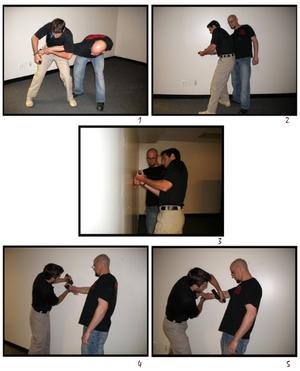Close quarter combat // Tzviel (BK) BlankchteinHandgun defense against a wall
One of the most dangerous tasks law enforcement personnel faces is disarming a suspect armed with a handgun; officers must remember that action is faster than reaction, and should thus take the initiative — and maintain it; the first part of any handgun defense is a redirection of the muzzle; typically, this is accomplished by one of two ways: redirecting the handgun itself, or physically moving out of the line of fire while controlling the muzzle direction; Israeli Combat System (ICS) stipulates a combination of muzzle redirection and a body defense done simultaneously

Defending against a handgun // Source: Tzviel Blankchtein
Dealing with a handgun is always tricky. There is an inherit risk in attempting to disarm a suspect armed with a firearm. Action versus reaction is manifested at its basics, where the officer’s initial response to the threat is racing against the suspect’s recognition of that action and his counter-action of squeezing the trigger or retracting the firearm to maintain control of it. As the saying goes, however, action is faster then reaction, providing the officer with the slight advantage in effectively fending such an attack.
It is widely accepted that the initial part of any handgun defense should be a redirection of the muzzle. Getting and staying out of the line of fire is the main objective. Typically, this is accomplished by one of two ways: redirecting the handgun itself, or physically moving out of the line of fire while controlling the muzzle direction.
Israeli Combat System (ICS) stipulates a combination of muzzle redirection and a body defense done simultaneously. Moving the handgun in one direction while moving one’s body in the opposite direction will allow for the greatest margin of error. In addition, it is typically easier for an officer to move himself or herself rather than fight an opponent. This is especially true if the opponent is larger or stronger.
The basic (if such a thing exists) handgun defense from the front will include a redirection of the muzzle by moving the suspect’s wrist away, while turning to the suspect’s “dead-side”. The weapon is then controlled by assuming an arm-bar position and performing a disarm. This procedure allows for maximum control of the muzzle and works for smaller and weaker officers fending a larger and stronger suspect (see picture 1).
When the officer and the suspect are standing against a wall, however, and the officer can no longer move to the suspect’s dead-side, an alternative is needed. It is imperative to mention that the defense can still be completed with the officer redirecting and moving to the suspect’s “live-side” (see picture 2). The defense and disarm remain the same with no changes needed. The only flaw, or risk, with such a move is that the officer will position himself or herself where a secondary threat, such as a headlock, may be present. That said, the officer should commit to his or her actions and complete the disarm, allowing him or her to then address the secondary threat.
A better, safer option does exist. The officer should recognize that the wall against which the two are standing is a viable tool. The officer can utilize the wall as part of the defense and control move.
The officer should use the far hand to redirect the handgun toward the wall. An explosive strike of the suspect’s hand against the wall may be all that is needed to get the suspect to drop the weapon. When the redirection is made the officer should blade his or her body in the opposite direction. As the suspect’s hand makes contact with the wall it will most likely recoil inward, and by blading the body the officer will assure that he or she remains out of the line of fire (see picture 3).
Almost simultaneously, the officer will use his or her free hand to redirect the muzzle upward and disarm the suspect (see pictures 4 and 5).
The officer must remember that whichever technique he or she uses, he or she must commit to and not second guess himself or herself. Once out of the line of fire, the officer should use whatever means necessary to remain out of the line of fire.
The officer should always transition to higher force options as needed, and use proper weapon retention techniques to assure the handgun is not taken back by the suspect.
Tzviel (BK) Blankchtein, a defensive tactics instructor, is founder and president of Masada Tactical, and may be contacted through the company’s Web site. Readers may send him questions on topics and issues which are of interest to them. He will post some of these questions, and his answers to them, in the column.
